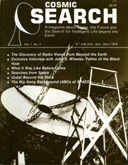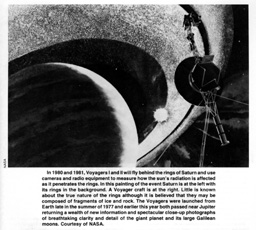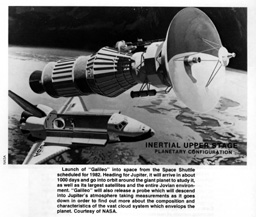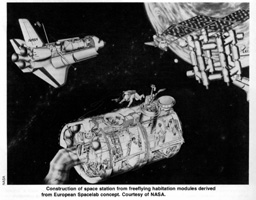![[NAAPO Logo]](../../Images/NAAPOsm.jpg) North American AstroPhysical Observatory (NAAPO)
|
|
Quest Beyond the Stars: Are We Alone?
By: Jesco von Puttkamer
This article is the second of two articles by Jesco von Puttkamer; the first, "Extraterrestrial Life: Where Is Everybody?", appeared in the Summer 1979 (vol. 1, no. 3) COSMIC SEARCH. His biographical sketch accompanied that article. This issue's article appeared earlier in "Future" magazine. Reprinted by permission of the author, Jesco von Puttkamer, Copyright © 1979.
"It is both timely and feasible to begin a serious search for extraterrestrial intelligence."
This quotation from a recently released NASA report is one of the major conclusions of a feasibility study on the Search for Extraterrestrial Intelligence (SETI), supported by a committee of distinguished scientists headed by Philip Morrison, a noted physicist at the Massachusetts Institute of Technology. The report proposes a seven-year program of progressive radio search for other civilizations in the universe based on present-day detection equipment. If there are radio signals coming toward our solar system from intelligent and communicative creatures in space, sooner or later a program like SETI should detect them.
The dream of communicating with species other than humans is one of the oldest of mankind. From the childhood enchantment of Dr. Doolittle to today's wondrous explorations into communication with primates and dolphins, and to the speculations and fantasies of science fiction, in which the notion of contact with extraterrestrial intelligences is solidly (and, lately, lucratively) entrenched, humans have always found great excitement and, yes! hope in the idea of exchanging knowledge with others, be it as teacher of less developed or student of more advanced species. Now, with the new revolution in scientific thinking regarding the plentitude of other planetary systems and the frequency of occurrence of intelligent life in the universe, science is seriously gearing up to tackle the problem of seeking other civilizations in space, saying, in effect, "We are not alone."
The idea of establishing radio contact with interstellar races by first searching for microwave signals using the radio-astronomy technology available to us was introduced to the scientific community in 1959 by Morrison and another physicist, Giuseppe Cocconi, in Nature magazine (see COSMIC SEARCH, January 1979). One year later, the radio-astronomer Frank Drake pointed a 27-meter antenna for about four weeks at two nearby stars, Epsilon Eridani and Tau Ceti, both about 11 light-years distant, searching for signs of intelligence. Named Project Ozma, the pioneering first attempt at SETI failed to detect signals though—which isn't too surprising in view of the brief, almost cursory nature of the search (see COSMIC SEARCH, January 1979). Since then, there have been other searches but the number of stars examined so far isless than one-tenth percent of the number that would have to be investigated to stand a reasonable statistical chance for discovering another civilization.
As I noted in the Summer 1979 issue of COSMIC SEARCH, the Milky Way galaxy may, at this instant, be the home of as many as one million civilizations at or beyond mankind's present level of development* (* A case could also be made for the opposing view, in which intelligent life is sparse in the universe: If the average lifetime of a technological civilization is much shorter than the assumed ten million years, we are practically alone; if the start-up and evolution of life happened later and slower than assumed, we may be standing in the morning light of the universe, among the very first of intelligent races.). With 200 billion potentially suitable stars in the Galaxy, there is a chance of 1 in 200,000 for each star to harbor one or more planets, and as many stars would have to be examined one by one. Less than 200 have been, so far.
There are billions of other galaxies in the observable universe, strewn through billions and billions of light-years. All of them may be cradles of life forms and intelligent races-billions of them. But the distance between us and them makes it highly unlikely that we'll ever receive signals from them unless it's from some hypothetical ultra-civilization that is so immensely far advanced beyond our level of development that its manifestations may appear to us as "cosmic wonders". To engage in a radio dialogue with such far-distant races of beings is out of the question. A two-way radio signal to even the galaxies closest to Earth, the Magellanic Clouds (at 200,000 light-years) and M31 in Andromeda (1.8 million light-years), would require 400,000 years and 3.6 million years, respectively.
Within our own Galaxy, too, distances beyond 1000 light-years will make two-way exchange unlikely. Civilizations are interested in microwave radio communications probably only for limited time. By the time the receiving race has answered the signal, more than 2000 years later, the supercivilization might have passed on to an advanced state beyond the communicative phase. Our main interest, at first, will therefore be on regions in space not over 1000 light-years away.
Star distribution varies widely throughout the flattened disk, nucleus and halo of our Galaxy, which measures 100,000 light-years in diameter, but the average separation between stars in the neighborhood of our Sun is about 7 light-years (i.e., one star in about 343 cubic light-years)* (* See Glossary for definition of light-year.). In a volume with a 1000 light-year radius around the Sun, therefore, there are sprinkled about 10 to 12 million stars. Assuming one third of them to be on the Main Sequence of the Hertzsprung-Russell diagram, thus having the "right" age, and half of these to be binary or multiple stars, of which only 10% may be suitable for a planet, we are left with 2.2 million suns which may have at least one planet with life.
Assuming further that one million supercivilizations are randomly distributed in the Galaxy, there should be about 55 of them within 1000 light-years from Earth. If all of them are radiating signals at us, we must investigate 40,000 stars to have a fair statistical chance of detecting a single extraterrestrial message—but the probability of being successful would still be only 63 percent. To raise our chances to 95 percent, the number of stars to be checked increases to 120,000. But if only 20 of the 55 civilizations are transmitting, it would have to be 330,000 stars.
Supercivilizations may be "talking" to each other across cosmic distances, but unless their communication beam is tightly bundled and Earth, on an extremely improbable chance, happens to come into the line-of-sight, we could not hope to detect other races by the "leakage" from their routine radio chatter at the longer distances.
But if "they" are the kind of creatures who—like humans—need and enjoy communicating, we could expect them to set up a beacon transmitting "call" signals, to facilitate the problem of initial acquisition by the hoped-for partner. The main dilemmas of SETI are that we don't know at what frequency in the radio spectrum to listen, and in what direction to point the antenna. Since the transmitting race is faced with the same questions, it may decide to set up continuous transmissions of sufficiently wide-bandwidth signals in all directions in space (isotropic), rather than a narrow-band, highly directional beam.
But such a "simple" omnidirectional beam requires tremendous transmitter power, and only a truly advanced supercivilization may be able to afford the energy expenditure—on the order of ten billion trillion (1022) watts—to transmit over a distance of 1000 light-years for nondirectional reception. This is about 3 billion times the total current power consumption of all mankind (about 7 trillion watts).
Speculations about such ultra-advanced civilizations, thought out by brilliant minds, have found their way into the scientific literature. The Soviet astrophysicist Nikolai Kardashev, for example, has boldly classified hypothetical advanced technological races in the universe in three categories according to the amount of energy they are capable of harnessing: Type I, at a level near that of our present-day Earth civilization, controlling about 7 trillion (7 x 1012) watts; Type II, civilizations capable of capturing and using the entire energy output of their central star, assumed to be of the power of our Sun (400 trillion trillion watts); and Type III, ultra-civilizations that command the energy of an entire galaxy, some trillion trillion trillion (1037) watts.
While we should be able to detect the signals of any Type II civilization in our Galaxy and those of Type III races anywhere in the universe, even without knowing beforehand where to look, if they use their tremendous power to transmit continuously in all directions, the omnidirectional beacon over distances less than 1000 light-years would require much lower power levels, on the order of a billion (109) watts. This would be within the capability of even Type I civilizations, but the need for high directivity of our receiving antennas in order to pick up these signals forces us into a serial search mode, in which one star is examined at a time. Earlier, we have seen that from 120,000 to 330,000 stars (perhaps even more) would have to be investigated within 1000 light-years for a 95 percent chance of success. If we spend 15 minutes with each star, the total search, not counting nonproductive "set-up" and "down" times, will take anywhere from four to ten years.
The second major problem of SETI, finding the wavelength or frequency of the putative signal, can be alleviated by using multi-channel receivers employing digitally "smart" multi-channel spectrum analyzers that listen to millions of narrow frequency bands at a time. Metaphorically, the classical needle-in-the-haystack dilemma of SETI, thus, becomes less formidable by having millions of hands to help sift through the hay. And we can try to "second-guess" the other civilization's transmitting logic in selecting most promising "universal" frequency regions.
In 1971, a study group under Bernard Oliver, sponsored by the NASA-Ames Research Center, proposed Project Cyclops, a large ground-based phased-array radio telescope of 10 kilometers diameter, consisting of 1026 dish antennas each 100 meters across, all electronically steered by a complex computer system. Cyclops could detect a billion watt beacon at a mind-staggering distance of 1000 light-years if it is sending in the cosmic "quiet zone" of the microwave spectrum, or leakage signals from a Type I race to 100 light-years. The wavelength range preferred for the search, originally proposed by Cocconi and Morrison, lies between 17 and 21 centimeters (1400 and 1727 megahertz). The region has been called the "water hole" because it is
bounded by the spectral lines of the water components hydrogen and hydroxyl (the OH ion), and it is hoped (perhaps, chauvinistically and erroneously) that other civilizations, dependent on water presumably as much as we are, might broadcast their signals in that range to facilitate the search. At these frequencies, Cyclops could detect a signal as weak as one photon per second per square kilometer.
Cyclops may also be built in space or on the backside of the moon, but because of its high price tag (ranging up to $10 billion depending on its evolutionary growth over the years), the more recent SETI study set its sights much lower. It is proposing a more modest project, starting with existing antennas and working itself up to larger ground- or space-based systems if it should become necessary to widen and deepen the search. The task would be rendered manageable by the development of multi-channel spectrum analyzers for, initially, examining a million and later a billion frequency "slices" simultaneously. As its name implies, SETI will limit itself to basic reconnaissance: it intends to listen rather than to transmit, to search rather than to announce.
We may speculate that the omnidirectional beacon somewhere out there in space would not only transmit—for as long as a thousand years, perhaps—a wide-band call signal designed to reliably establish the source as an artificial object from a tremendous number of natural radio sources in the universe, but also an interspersed narrow-band stream of information with some repetition cycle. This way, reception of the first "batches" of information would not have to await our acknowledgment of acquisition of the call signal. Of course, even if we succeed in decoding and understanding the message, we may not comprehend
its meaning. Intelligibility is the ability to tell what the message is saying; comprehension requires the ability to translate the message into images of real situations familiar to us.
Inter-species communication with extraterrestrial creatures by electromagnetic waves over interstellar distances, as we can see, is severely limited by such factors as extreme time intervals for two-way transmissions, fundamental differences in biological and social evolution causing difficulties in message comprehension, lack of physical contact for biological research and exchange of material objects, inability to contact less developed races and to explore nonintelligent life forms and physical phenomena in the universe, and absence of that special sense of adventure and excitement which comes with physical expansion and exploration. If interstellar spaceflight were possible, these limitations would disappear.
With our present-day technology, we are still eons away from making starflight a practical proposition for humans. Let's face it: the distances to be transversed within reasonable flight times are simply too large. The reaction mass and energy required for the trip even to the nearest stars, the triple-star system of Alpha Centauri (4.3 light-years) or Barnard's star (a dim red dwarf about 6 light-years away), are too great to be contained in a manned rocket. Using the most advanced spaceship engine concept currently foreseeable, controlled thermonuclear fusion with laser ignition, we could make the round-trip to Alpha Centauri in 82 years. Racing along at a maximum clip of 10 percent of the speed of light—30,000 kilometers per second—we would burn up about 81,000 tons of propellants to drive a 10,000-ton ship. Even with the ultimate rocket propulsion system, the photon rocket with matter-antimatter annihilation and zero-loss conversion of the liberated energy into photic propulsion thrust, which could achieve velocities close to that of light, the Alpha Centauri run would take 5 years
each way, and a 1000-ton ship would have to annihilate 33,000 tons of matter enroute, releasing some 3 trillion trillion joules of energy which, at 0.1 cent per kilowatt-hour, would represent about 900 trillion dollars worth of nuclear fuel.
Sending out unmanned interstellar probes on one-way voyages would be an alternate and easier way of establishing physical communication. One concept, proposed by a study group of the British Interplanetary Society, is Project Daedalus, an interstellar probe to Barnard's star. The design calls for a two-stage rocket, both stages powered by nuclear fusion reaction engines using pellets of deuterium and helium-3, ignited by high-powered electron beams. The 4000-ton probe would require 50,000 tons of propellants and travel at 12 percent of the speed of light, taking some 60 years for its mission. Such interstellar probes could be launched by extraterrestrial intelligences, too. Ronald Bracewell of Stanford University, who first discussed this possibility, has suggested that we be alert for such probes (called "Bracewell probes") in our own solar system right now. In science fiction, Arthur C. Clarke used the idea for the film 2001-A Space Odyssey.
But if there really are highly advanced technological races in the Galaxy, at least those of them that feel, like humans do, the urge of physical expansion and exploration may have developed mighty interstellar spaceships. How long would it take such a supercivilization to colonize the Galaxy?
Colonization time depends on travel time, time to establish a settlement, possibly on more than one planet of the new system, and a new population with an adequate industry and large enough resources base, and time to build a new fleet for further expansion.
Let's assume that a civilization must reach a "critical mass" of, say, ten billion people to develop motivation for interstellar travel and be able to afford it (Earth today: about four billion). Let's further assume that from each established society 10,000 individuals, along with whatever plant life and livestock they need (perhaps in forms of deep-frozen genetic material and embryos), succeed in reaching another star in their Space Arks and settling at least one planet.* (*Our supercivilization would probably send out other groups at later times, but let's assume that they consider their cosmic duty done after dispatching enough ships to establish at least one 10,000-people colony.) If the average distance between planetary systems is 10 light-years and the travel velocity one-tenth the speed of light, it would take our expedition 100 years to reach a new system. To establish a settlement and build up a new population of ten billion would then take another 470 years, if the annual population growth rate is 3 percent. Launching a new expedition of 10,000 colonists, it would then take again 100 years to reach the next planetary system, and 470 years to build a society. Thus, the total colonization time for each new system (and to advance ten light-years), is 570 years. In our scenario, colonization of the Galaxy would take place at an average expansion rate of 2 percent of the speed of light, or five million years to cover the Galaxy from edge to edge, assuming just one star-faring race.
What if the hypothetical race nearest to Earth, an average 250 light-years away, is engaged on such a long-range colonization program in this very moment! If they embarked on it 15,000 years ago, they'll reach our solar system any day now .....
But what are the odds for such a surprise visit? Not all of our one million supercivilizations can be expected to be capable of or to be interested in paying the high price of colonizing the Galaxy, to " . . . explore strange new worlds, to seek out new life and new civilizations." If only one percent of them are roaming the Galaxy seeking suitable planets, there would be a total of ten-thousand star-travelling supercivilizations with an average of ten million planets each to visit (assuming a random distribution of 50 to 100 billion planets). If each civilization's "star trekking" effort is determined enough to yield one new planet per year, it would take their fleet ten million years to visit all planets, or the equivalent of a supercivilization's assumed lifetime.* (* Science fiction, of course, can be more flippant with the subject of galactic colonization, especially when pursued by network television. For STAR TREK'S starship Enterprise, under orders by the TV producers to visit one planet per week (or about 25 planets per TV "season"), the job would have been much easier: it could have speeded up galactic exploration 125-fold. With a fleet of 50 Enterprise-class starships, Starfleet Command could explore a million planets in 800 years, finding an estimated 100,000 intelligent life forms, of which 10,000 would have developed technology. But, then, these fabulous ships were equipped with the superphotic (faster-than-light) Roddenberry Warp Drive, strictly from the realms of fantasy.) If they started checking planets about 100,000 years ago, each civilization would have catalogued only 100,000 planets by now, and the chance for Earth to be visited this year would be negligible—one in 10 million.
All in all, we can conclude that interstellar flight by mere earthlings is out of the question not only for the present but also for at least the next two or three decades. It is not a physical impossibility but an economic one, and new breakthroughs must occur to enable man to travel to the stars. In the meantime, SETI offers a chance of finding a star race that could perhaps help us to make such breakthroughs happen.
But why would a supercivilization go to the enormous expense of erecting an omnidirectional one-way beacon in the first place? Could it be that a society's future development is to some extent contingent on reception and assimilation of information from supercivilizations, perhaps leading to a rapid jump of the society to the highest level? This so-called "feedback effect" was suggested first by Sebastian von Hoerner. The information thus received may be the chance for a civilization to "improve" itself rationally. In its widest sense it could perhaps mean that contact with extraterrestrial intelligences is a necessary prerequisite for a race to survive and to become a "supercivilization" itself,—which would make SETI one of the most imperative ventures of mankind. Can we afford the risk to assume this isn't so?
As suggested by Bracewell and others, the emerging race would then join a galactic community of supercivilizations and, in that process, partly in repayment of the galactic equivalent of a "student education loan", assume its share of the "Club's" obligation to establish a beacon and in turn help other lower civilizations to make the grade—a bit like a galactic chain-letter program. As the Project Cyclops report commented, the start of such a community chain effort is difficult to explain but may have been like the beginning of life itself—not in any single trial by some earlier race, but after perhaps millions of attempts, of which only a few (or one) need to have been successful to start the whole process.
The first interstellar messengers from Earth are already underway.
|




